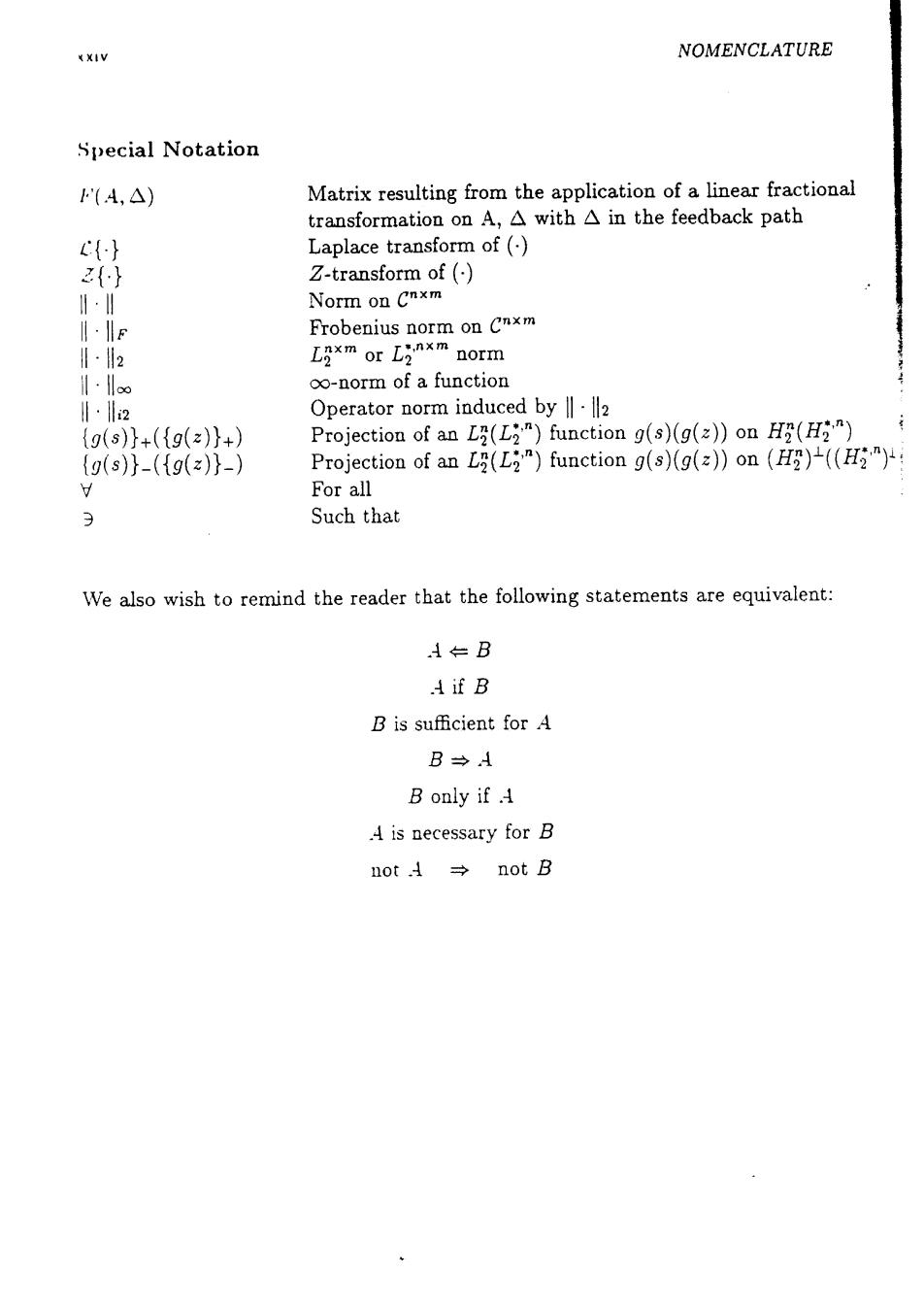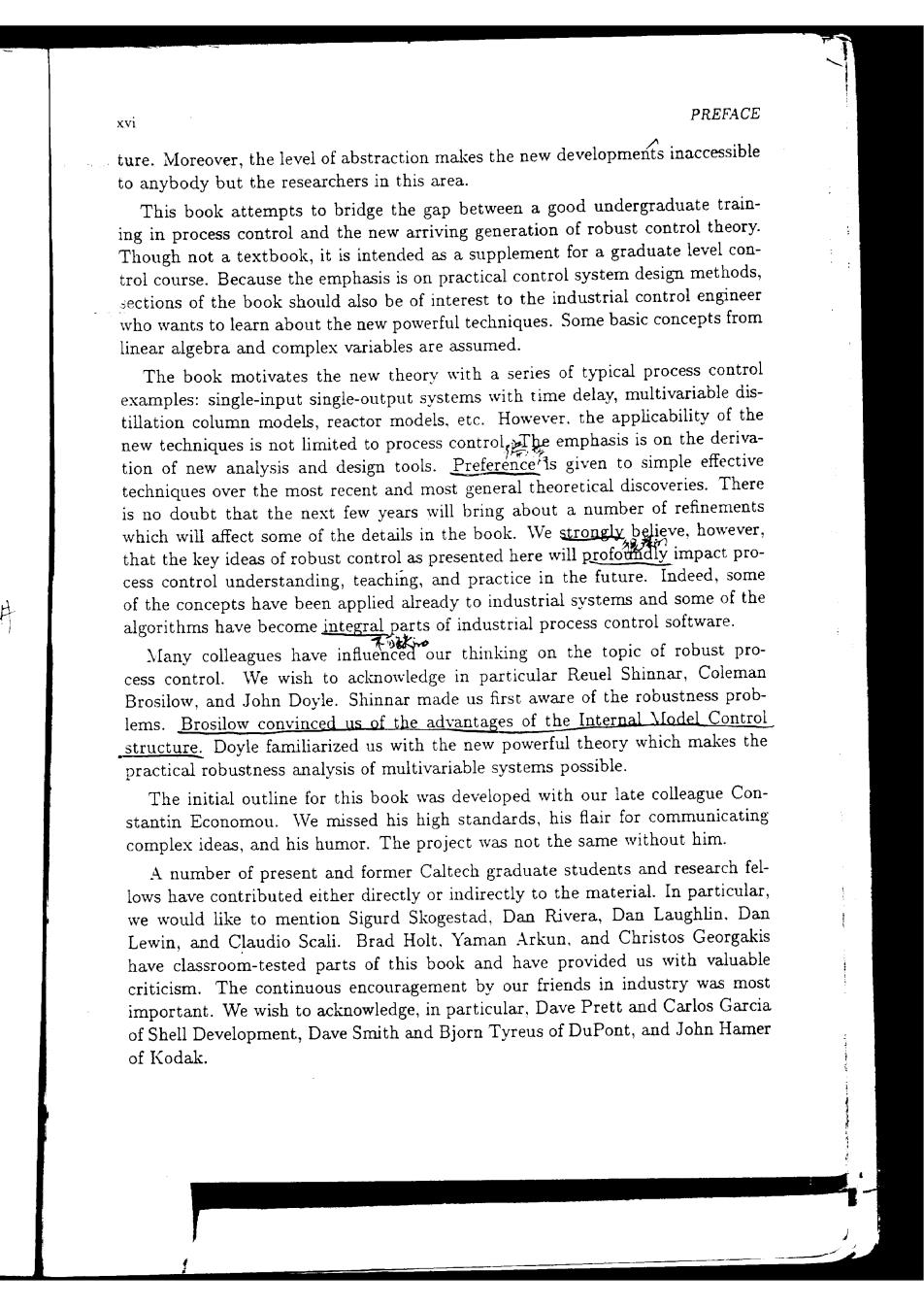
NOMENCLATURE xxiii ((E()) SISO (MIMO)discrete sensitivity function (s),E(s)(a(s),Ea(s))Setpoint tracking (disturbance rejection)SISO and MIMO (approximate)continuous nominal sensitivity function for sampled-data systems E.(s)(E.(s)) (Nominal)MIMO continuous sensitivity function for sampled-data systems;it depends on whether v=d (approximation)or v=r (s)(S(z) Zero polynomial for the continuous (discrete)case 7(s,H(s(7(s),H(s) (Nominal)Complementary sensitivity function for the continuous SISO and MIMO cases respectively 7(s) first-step IMC complementary sensitivity function n(2H()》 SISO (MIMO)discrete complementary sensitivity function i-(s)(H(s)》 Setpoint tracking SISO(MIMO)continuous nominal complementary sensitivity function for sampled-data systems K(K) (Minimized)condition number Kd Disturbance condition number KR Rijnsdorp IM 1(A) RGA matrix of the matrix A 入(4) ith eigenvalue of A 入(1) ij-element of A(1) (.)or4A(A) SSV of A for same specific set A Π Set of possible plants x(s)(() Pole polynomial for the continuous (discrete)case ()(x*(w) Uncertainty region on the Nyquist plane for the continuous (discrete)case p(.) Spectral radius of A (1) Maximum singular value of A (1) Minimum singular value of A (.1) ith singular value of A o() Factor included in f()to satisfy the requirements on the IMC filter B Closed-loop system bandwidth 山3 Sampling frequency Superscripts H Complex conjugate transpose of a matrix T Transpose of a matrix ⊥ Orthogonal complement of a function space

NOMENCLATURE Special Notation '(4,△) Matrix resulting from the application of a linear fractional transformation on A,A with a in the feedback path c{} Laplace transform of ( 2{} Z-transform of ( ·‖ Norm on cnxm Ile Frobenius norm on cnxm l·l2 L经xm or L2 nxm norm l·l∞ oo-norm of a function ‖·l2 Operator norm induced by‖·il2 {g(s)}+({g(z)}+) Projection of an Lz(L2")function g(s)(g(z))on H2(H2") {g(s)}-({g(z)}-) Projection of an L2(L2)function g(s)(g(z))on (H2)((H) For all Such that We also wish to remind the reader that the following statements are equivalent: -B A if B B is sufficient for A B→A B only if A is necessary for B not.A→notB

PREFACE The development of the state space approach in the early 1960s made it possi- ble for the first time to solve general linear multivariable control problems with relative ease.The new techniques seemed to hold high promise for practical ap- plicatons and attracted much instat least in the academiccomunity Fifteen years later several review papers (e.g..Foss.1973:Kestenbaum et al., 1976)concluded that the impact on the industrial practice had been negligible. 斯 ,数了2e高沈河 A number of possible reasons for this failure can be identified.For example, there was no smooth transition from the established and proven techniques and tools (PID controllers.Smith Predictor.Relative Gain Array,Decoupler,etc.)to the new ones.This led to great educational difficulties and from today's perspec- 2 tive pointless debates in which the classic frequency domain approach was pitched against the modete space techniquesore serious than this lack of nder standing which persisted for aimost two decades was that the new techniques did not address some very fundamental issues which are at the very heart of feed- back design.For example.the concept of"nonminimum phase behavior"seemed forgotten.Also.the problem of model uncertainty and model error,which domi- nates process control,was only addressed via sensitivity analysis,whose validity is limited to tamodelerubaton After years of isolated but persistent criticism a new understanding and ap- proach started to emerge in the late 1970s.Some of the key theoretical con- tributions were the new formulation and parametrization of the optimal control problem by Youla and coworkers (1976),the definition of the Hoo control problem by Zames(1981),and the introduction of the structured singular value by Doyle (1982).These and other discoveries sparked again much enthusiasm and a furry of research activity almost comparable to the 1960s.Only time will show the impact on the control practice. 以是和 The new approach does address many issues of practical importance like model uncertaint;(custness).Many research challenges remain however.New results appear monthly but the ideas have not matured enough to form a coherent pic- XV

PREFACE xvi ture.Moreover,the level of abstraction makes the new developments inaccessible to anybody but the researchers in this area. This book attempts to bridge the gap between a good undergraduate train- ing in process control and the new arriving generation of robust control theory. Though not a textbook,it is intended as a supplement for a graduate level con- trol course.Because the emphasis is on practical control system design methods, sections of the book should also be of interest to the industrial control engineer who wants to learn about the new powerful techniques.Some basic concepts from linear algebra and complex variables are assumed. The book motivates the new theory with a series of typical process control examples:single-input single-output systems with time delay,multivariable dis- tillation column models,reactor models,etc.However.the applicability of the new techniques is notlimited to processoeemphasis ison the deriva- tion of new analysis and design tools.Preference is given to simple effective techniques over the most recent and most general theoretical discoveries.There is no doubt that the next few years will bring about a number of refinements which will affect some of the details in the book.We strongly believe,however, that the key ideas of robust control as presented here will profody impact pro- cess control understanding,teaching,and practice in the future.Indeed,some of the concepts have been applied already to industrial systems and some of the algorithms have become integral parts of industrial process control software. Many colleagues have infuenced our thinking on the topic of robust pro- cess control.We wish to acknowledge in particular Reuel Shinnar,Coleman Brosilow,and John Doyle.Shinnar made us first aware of the robustness prob- lems.Brosilow convinced us of the advantages of the Internal Model Control structure.Doyle familiarized us with the new powerful theory which makes the practical robustness analysis of multivariable systems possible. The initial outline for this book was developed with our late colleague Con- stantin Economou.We missed his high standards,his flair for communicating complex ideas,and his humor.The project was not the same without him. A number of present and former Caltech graduate students and research fel- lows have contributed either directly or indirectly to the material.In particular, we would like to mention Sigurd Skogestad,Dan Rivera,Dan Laughlin.Dan Lewin,and Claudio Scali.Brad Holt.Yaman Arkun.and Christos Georgakis have classroom-tested parts of this book and have provided us with valuable criticism.The continuous encouragement by our friends in industry was most important.We wish to acknowledge,in particular,Dave Prett and Carlos Garcia of Shell Development,Dave Smith and Bjorn Tyreus of DuPont,and John Hamer of Kodak

xvii PREFACE Much of the research reported in this book was carried out at Caltech.The extraordinary scholarly environment and supportive administration made this endeavor possible.The final sections of the book were completed while the first author enjoyed an appointment as the Gulf Visiting Professor of Chemical Engi- neering at Carnegie Mellon University.During the past year,the second author held a joint appointment with the Chemical and Nuclear Engineering Department and the Systems Research Center of the University of Maryland.The excellent atmosphere at this institution allowed him to continue his work on the book. Over the years we received continuous financial support from the National Science Foundation.the Department of Energy,Shell Development,DuPont,and Kodak which enabled us to pursue our research objectives. Finally we would like to thank Glenn C.Smith for preparing most of the figures,Evangelos Petroutsos for assisting with TEX and IATEX and Jan Owen who did such an excellent job typing the manuscript after suffering through three different word processing systems. M.Morari E.Zafiriou